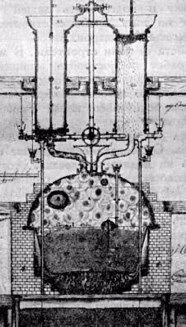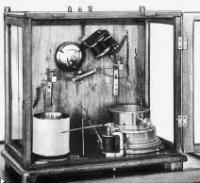The Firsts - Groundbreaking achievements, inventions and the pioneers. Pre 1900. Page 2


One of the first radio receivers, constructed by Russian engineer Alexander Stepanovich Popov in 1895 as a lightning detector. On May 7, 1895, he demonstrated the reception of radio pulses from a spark-gap radio transmitter. Along with Guglielmo Marconi, Popov shares credit for the invention of the radio receiver, and the first radio communication. May 7 is celebrated in as Radio Day in Eastern Europe.
The device consists of a primitive radio wave detector called a coherer, a glass tube containing metal filings between two electrodes (center). The electrodes were connected to a suspended wire antenna and a ground connection. When a radio wave struck the antenna, the coherer would become conductive. The coherer was also connected to a DC circuit with a battery and a relay (metal cylinder, bottom right). When the coherer became conductive, current from the battery would turn on the relay, which would send current through an electromagnet to pull an arm over and ring a bell (upper center).
When the clapper arm sprang back it would tap the coherer tube, jarring the filings, resetting it to its nonconductive state, making it ready for the next radio signal. The relay would also send a pulse to a chart recorder (white cylinder) which would make a mark on a chart paper, recording the occurrance. In 1896 Popov mounted the device on the roof of the Military Academy, and it recorded lightning strikes up to 50 km away.
The first dam
The first dam we know about was built in 4000B.C. across the Nile river in Egypt.
Inventor of the first watch
It's believed that a locksmith named Peter Henlein from Nuremberg, Germany invented the first watch in the early 1500's.
The Umbrella
That indispensable article which everybody should lay by for a rainy day, the umbrella, has not been brought to its present state of excellence without the exercise of much thought and ingenuity. The umbrella was one of the earliest inventions; its effigies may be found in sacred scriptures of great antiquity. In China it has been in use from time immemorial, and to this day in the East the title "lord of many umbrellas " is one of great significance, denoting its possessor to be a sublime personage. In England, the umbrella did not come into general use until the early part of the seventeenth century, and was at first ridiculed as an absurd contrivance of the fanciful Italians, but it soon became popular. During the period comprised between October, 1786 and 1861, no Iess than 392 English patents were granted for improvements in the construction of these useful Articles.
Early Telegraphs
Very few people, says Railway Locomotive and Engineering, would doubt the electric telegraph being exclusively a modern invention, yet experiments were made centuries before the electric telegraph came into use, which indicated that a system of electric telegraphy could have been worked out had the need of it existed. In 1746 Le Monnier exhibited a series of experiments in the Royal Gardens at Paris showing how erectricity could be transmitted through iron wires 95Q fathoms in length. In 1753 Charles Marshall published a remarkable description of the electric telegraph in the Scots' Magazine under the title of "An Expeditious Method of Conveying Intelligence.
" In 1846 George Lewis Lesage, professor of mathematics at Geneva, promulgated an invention of an electric telegraph, which he eventually completed and set to work In 1774. This system was composed of twentyfour metallic wires, insulated and inclosed in a non-conducting substance. Each wire ended in a stock mounted with a little ball of elder pith and suspended by a silk thread. When a current of electricity was sent through the wire the eider ball at the opposite end was repolled, the movement designating a letter of the alphabet. By this means words could be spelled out. It was a crude method, but it was a complete electric telegraph system. The reason why this and other inventions of a similar nature never came into general use was that the need had not arrived.
First Telescope
As far back as the 1200's, scientists experimented with magnifying lenses. Then in 1608, a Dutch optician named Hans Lippershey made what historians believe could be called the world's first telescope. But Lippershey was refused a patent for his invention. Hearing about Lippershey's instrument, the Italian astronomer Galileo in 1608 built his first telescope. It was a crude instrument that magnified objects only 33 times.
An English scientist, mathematician and astronomer named Sir Isaac Newton during the early 1700's came up with a new type of telescope: it made use of a reflecting mirror instead of a combination of lenses, which had been used earlier. Using an eye piece on the side, the instrument is known as the Newtonian telescope. Newton's telescope is a clumsy looking instrument, nine inches in length, two inches in aperture and capable of magnifying thirty-eight times. It was entirely made by Newton himself. A bit later, in France, a scientist named N. Cassegrain came up with another type of reflecting telescope which is called the Cassegrainian. One of the largest reflecting telescopes is the world is the Hale telescope. It has a reflecting mirror of 200 inches.
Another source says:
The invention of the telescope is commonly attributed to Galileo, but M. Camille Flammarion shows in the Revue that the merit does not entirely belong to the great teacher of mathematics at Pisa and Padua. A rare work printed at The Hague in 1655, written in Latin by Peter Borel, physician to the king of France, and dedicated to the senate and people of Middleburg, the metropolis of Zealand, states that "the injustice of men has taken away from your city a glory which justly belongs to it. The true inven- tor of the telescope is Zachary Joannides, spectacle maker, who fitted up the two first lenses in 1590, the one concave and the other convex, joined by a tube."